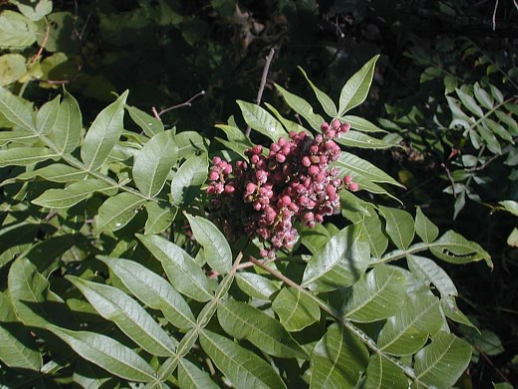- 2024 Native Trees
- >
- Shrubs
- >
- Winged Sumac (Rhus coppallinum)
Winged Sumac (Rhus coppallinum)
Height: 5 to 12 feet
Spread: 8 to 15 feet
Bloom Time: July to August
Bloom Description: Greenish
Sun: Full sun to part shade
Suggested Use: Erosion Control , Fall Color, and Naturalized area
Tolerate: Drought, Black Walnut, Clay Soils, Strip Mine Ground
Native to: Jefferson County
The Winged Sumac is the Marilyn Munster of the Sumac family, with redeeming qualities that make it an oddity when compared to the rest of the clan.
Winged Sumac is sometimes referred to as dwarf sumac or flameleaf sumac because of its smaller stature in comparison to the sumac family and its brilliant red leaf color in the fall.
The Winged Sumac should be planted in a grouping, or along natural areas in the landscape. A multi-trunked deciduous shrub that has an open growth and will colonize if left unchecked. they are fast growing, generally pest and disease-free, and drought-tolerant. Colonies are often single-sexed, formed from a single, suckering parent. Only female plants produce berries. The Winged Sumac is a dioecious species with separate male and female plants. Only the females produce berries. The shrubs offered in the Jefferson Soil and Water Conservation District Native Plant Sale are unsexed shrubs, so it is recommended to buy multiple shrubs.
The leaves are large and compound and contain 9 to 21 leaflets with smooth edges. Leaf midribs have a wing like appearance giving rise to the common name. Leaves turn a show stopping vibrant red in the fall, making the plant a must have.
This plant provides nectar for pollinators. It is a larval host plant to 56 varieties of butterfly and moth species. Pollinators are heavily attracted to the summer flowers of the shrub. Red-Banded Hairstreak. It is also a host plant for the Luna moth. Butterflies and bees nectar at the flowers. Its fruits are eaten by songbirds, white-tailed deer, opossums, wild turkey, and quail while rabbits enjoy the bark in winter.
At the Moss Gibbs Woodland Garden in Louisville, Kentucky several specimen plants are growing on the grounds providing an excellent display throughout the year. Thomas Jefferson sought out the plant to be distributed to his friends because of the autumn colors. ■






